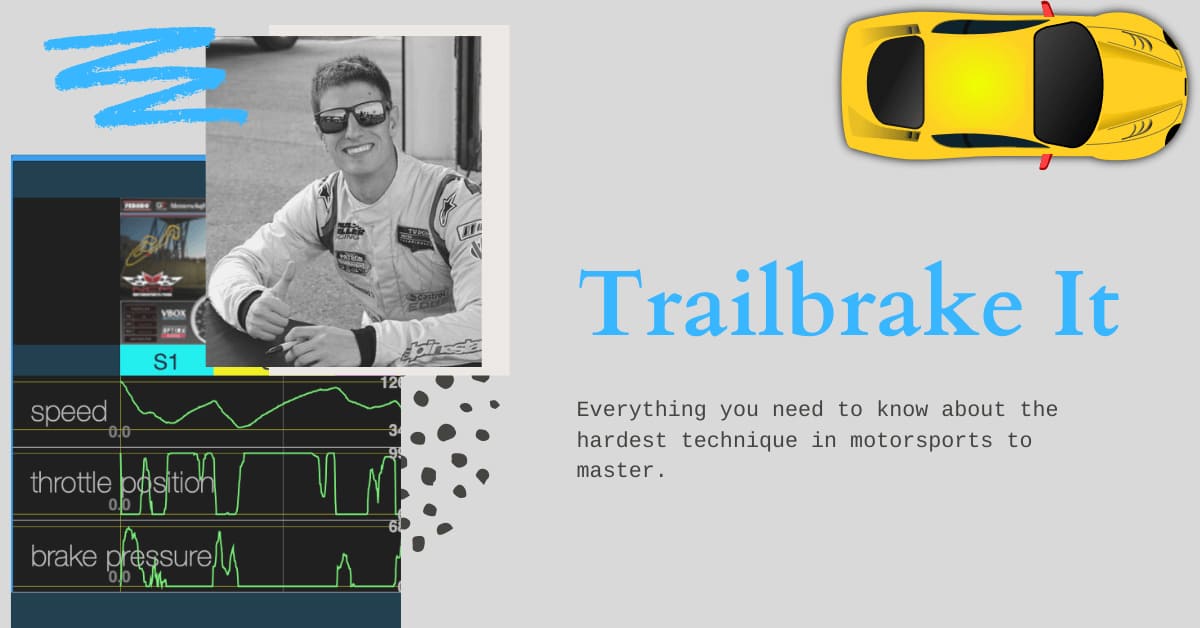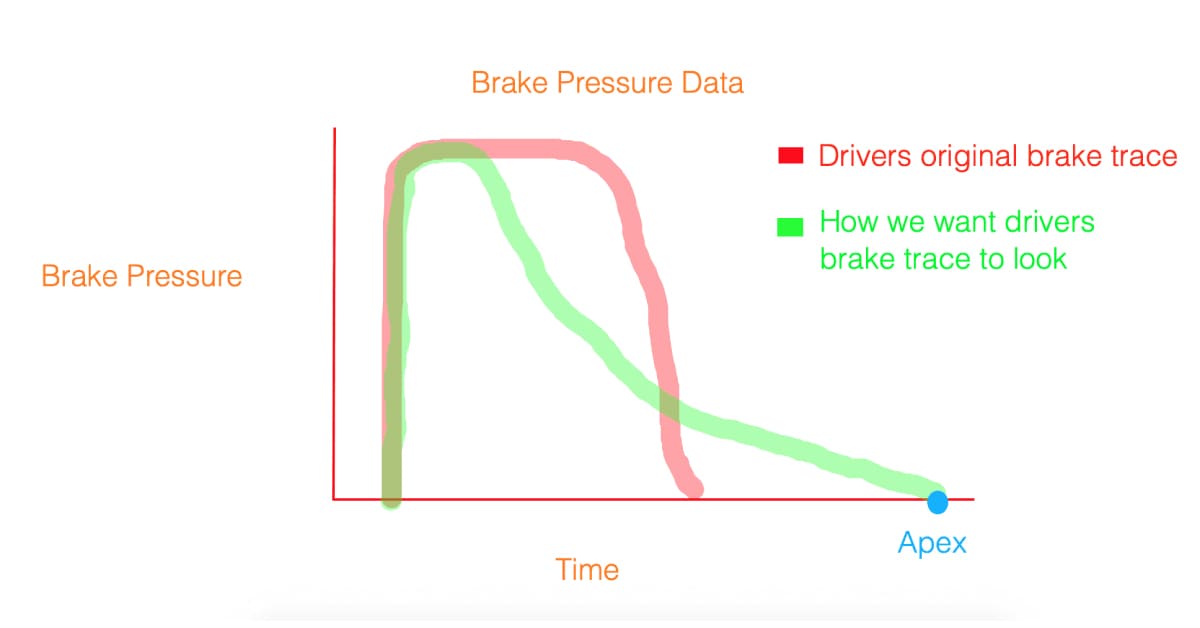The number one skill that our race car coaches see drivers struggle to accomplish accurately is the ability to trail brake. This technique separates the great drivers from the good drivers and the good drivers from the novice drivers. Blayze Pro-Racing Coach Dion von Moltke discusses trail braking and how to improve your performance on the track by using proper technique.
If you want to view the full in-depth and free masterclass article on trail braking click here!
What Is Trail Braking?
Trail braking is applying a small amount of brake pressure as the car carves all the way down to the apex. During the trail brake zone (after the initial turn, and sometimes down to the apex), one does not apply a lot of brake pressure as the main goal isn't to slow down the car. Yes, we are doing that, and it did allow us to brake deeper, initially; but the main reason to trail brake is to keep weight on the front nose of the car as it turns.
Why Do We Want to Keep the Weight on the Front?
There are two main reasons for keeping weight on the front and they both are about one core principle, spending more time at full throttle:
- Shifting The Braking Zone : On the race track, we want to maximize time spent at full throttle. By trail braking we will be able to shift our braking zone closer to the apex of the corner. If we only brake in a straight line that means we need to brake earlier (less time on full throttle into the corner) to bring our speed down before turn in. The slow blend of speed after turn in helps us brake just a little bit deeper.
- Rotation: Trail braking also helps us get back to full throttle earlier at corner exits. The weight on the front nose helps us get rotation at corner entry thru the apex, this will give us a better car angle at the car apex and start to unwind the steering wheel earlier and more aggressively at the corner exit. Both of which allow us to get back to the throttle more aggressively and pick up full throttle earlier.
Do We Ever Not Trail Brake?
Yes, there are a few exceptions to the rule. Example corners where we don’t trail brake are almost all limited to high-speed corners where we do not need to brake on corner entry. Some examples of corners on different race tracks would be:
- The Kink at Road America
- Turn 8 at Thunderhill
- Turn 12 at Road Atlanta
You will notice there is a constant theme in these corners. All high-speed corners where we don’t brake at all. For nearly every other type of corner where we will be braking, we will have some form of trail brake.

Take your trail braking to the next level by watching the full Blayze trail braking webinar! For Blayze+ members only, click here to watch!
This may mean we will see less initial brake pressure to be able to extend our brake zone to be longer but with lighter pressure for corners with typically short brake zones. This is a great technique for the higher speed corners where we still need a little bit of braking to be done. The lighter pressure allows less weight to be transferred to the front end, which will keep the rear more settled. This allows us to still have the front grip we want without getting that over-rotation after turn in.
How To Trail Brake
The way I like to teach trail braking is as a 3-step process. The first step of this process is identifying where our initial throttle application spot comes in.
Initial Throttle Application
This is a golden rule that our race car coaches focus on. We tell our drivers the following, “You are not allowed to get to throttle until the apex. Until the point, you can start to unwind the steering wheel.”
We want to develop this discipline. To understand why let’s talk about the two reasons why we see drivers apply the throttle before the apex:
- They feel the car has too much oversteer, and the throttle settles the rear.
- The driver has over slowed, and when we over slow the only thing we can do is get to throttle.
Let’s talk about point 1 first. A little bit of maintenance throttle will settle the rear and create understeer. There are some cases we want to do this, but in almost every scenario this will hurt us more than it will ever help. For most drivers the oversteer they are trying to fix is a good oversteer, we want that oversteer to rotate the car so we have the car pointed in the right direction mid-corner.
I like the drivers I work with at Racers360 to think about maintenance throttle in the following way: Sure, it may make the car feel better. But, you are essentially taking the ceiling of the ultimate amount of grip your car has, or the ultimate amount of entry speed you can bring in while still getting the perfect exit, and significantly lowering it. We need that weight on the front nose and that rotation to drive at a high level. I would rather you focus on learning car control and experiment with the line for where a good level of rotation turns into too much rotation, rather than preventing any rotation from happening at all. Now for point 2. I want to break the bond between over slowing and getting to throttle. We should NOT relate the two in our minds.
If we can be completely disciplined on not allowing throttle before the apex we may feel too slow on entry but we don’t want to create a bad habit along the way. Instead, once we feel like we are over slowing while turning into the corner and we take away the option of going to throttle to fix this issue our brain will naturally look for another solution to its problem.
There are only two ways to fix over slowing. Those options are:
- Picking Up Throttle Too Early - Bad Solution
- Rolling More Entry Speed Next Lap - Good Solution!
Rolling More Entry Speed
Now that we have built our discipline of not picking up initial throttle before the apex, we can focus on rolling more entry speed. The first step of this next process is NOT braking deeper.
We first focus on the back end of our brake zone. Initially, I want the drivers I work with to do everything in the brake zone the same.
Once they have mastered the discipline of the throttle application, they will want to naturally start to roll in more entry speed. Once they get to this stage, I want them to focus on braking at the exact same initial spot, with the nice threshold pressure early in the brake zone. But here is the key thing that we tell them:
Focus on getting off of threshold brake pressure earlier and extending our brake zone to be longer but with much less time spent at heavy pressure and much more time spent on very light brake pressure. Releasing the brakes should be a very slow process as we enter the corner.
The following graphic explains what we want to see using a data graph example. The red line would be how their brake zone initially looks and the green line looks like what we see our drivers doing after a session with a Racers360 coach.

The Final Part
The very last thing that we want to see our drivers start to work on is braking later. Only once they have mastered step one and two. Once they have mastered step 2 and still feel like they are over slowing, that is when we can focus on braking deeper.
It is so important to do this last not only because it is the highest risk part, but also because for lap time braking deep does nothing for us if we can’t combine it with good entry speed, a good turn in, a good apex, and a great exit. Figuring all the rest out first lets us know what it all is supposed to feel like, and we will know if we brake too deep because we won't execute the rest of the corner how we want to.
When race car drivers get to this stage, we teach our drivers to slowly bring their brake zones later and later lap by lap. Our objective here is to get it to the point that we start to make small mistakes such as:
- Missing our turn in point
- Too much brake pressure still on after turn in
- Locking up the tires during straight-line braking
- Too much entry speed so we miss the apex or can’t get to throttle where we want to
Once we start making these mistakes, we back up that brake zone slightly and then we know we are right at the limit!
Another great article and video we have on trail braking can be found here: What is trail braking & why is it fast.
Learn More With Blaze!
The secret to mastering any skill is practice! Are you looking to start your racing journey? Could you use direct feedback from a professional coach on how to improve your racing and motorsport skills?
At Blayze we give you a personalized coaching session from the very best coaches in the world. For a truly unique and personalized feedback experience, submit your performance video to one of Blayze’s highly qualified coaches. The custom-developed coaching session can help you improve your on-track, so you are performing at your very best in every race. One easy click here will take you to more details on our coaching sessions.

